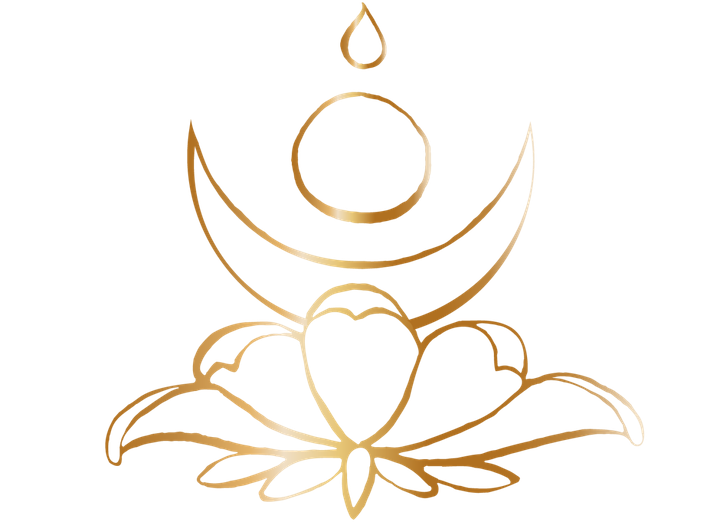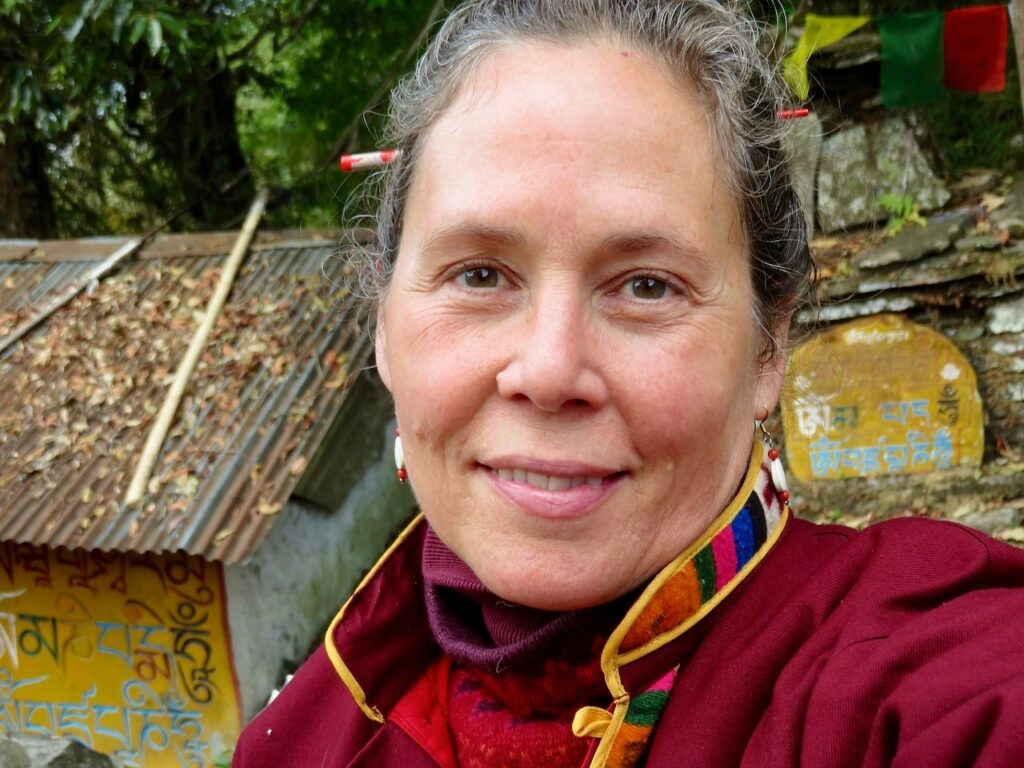
Khandro Kunzang is a Buddhist practitioner and teacher and holder of the Khandro T’hug-t’hig path, the Dudjom Tersar, and the Rigdzin Sogdrub yogic practices of the Northern Treasures lineages.
Time notes:
00:01:30 The mandala principle
00:04:32 Enlightened organizing principle of the universe
00:09:45 Mandalas for practice
00:16:12 Vajrakilaya mandala
00:19:25 Field of blessing
00:21:22 Lama Dawa and Guru Rinpoche Prophecies
00:24:18 Lama Dawa mirror divining the locations for Vajrakilaya mandalas.
00:27:16 Elements as vehicles for blessings
00:31:00 Subtle and physical aspects of elements
00:35:00 Disrupting and repairing subtle realms of existence
00:46:00 Building and empowering the Vajrakilaya mandalas
00:51:00 Working up to practicing Vajrakilaya
00:56:00 Qualities of the phurba
00:57:28 When to begin wrathful practices
01:04:00 Not making plans
01:06:00 The story of Guru Rinpoche and Vajrakilaya in Yanglesho
01:08:00 On Yeshe Tsogyal using Vajrakilaya practice
Note: The Consecration of the Vajrakilaya P’hurba at Phurba Thinley Ling will be July 20th, 2026
~
Khandro Kunzang & the P’hurba Peace Mandala Project
https://www.phurbathinleyling.org/the-peace-mandala-project/
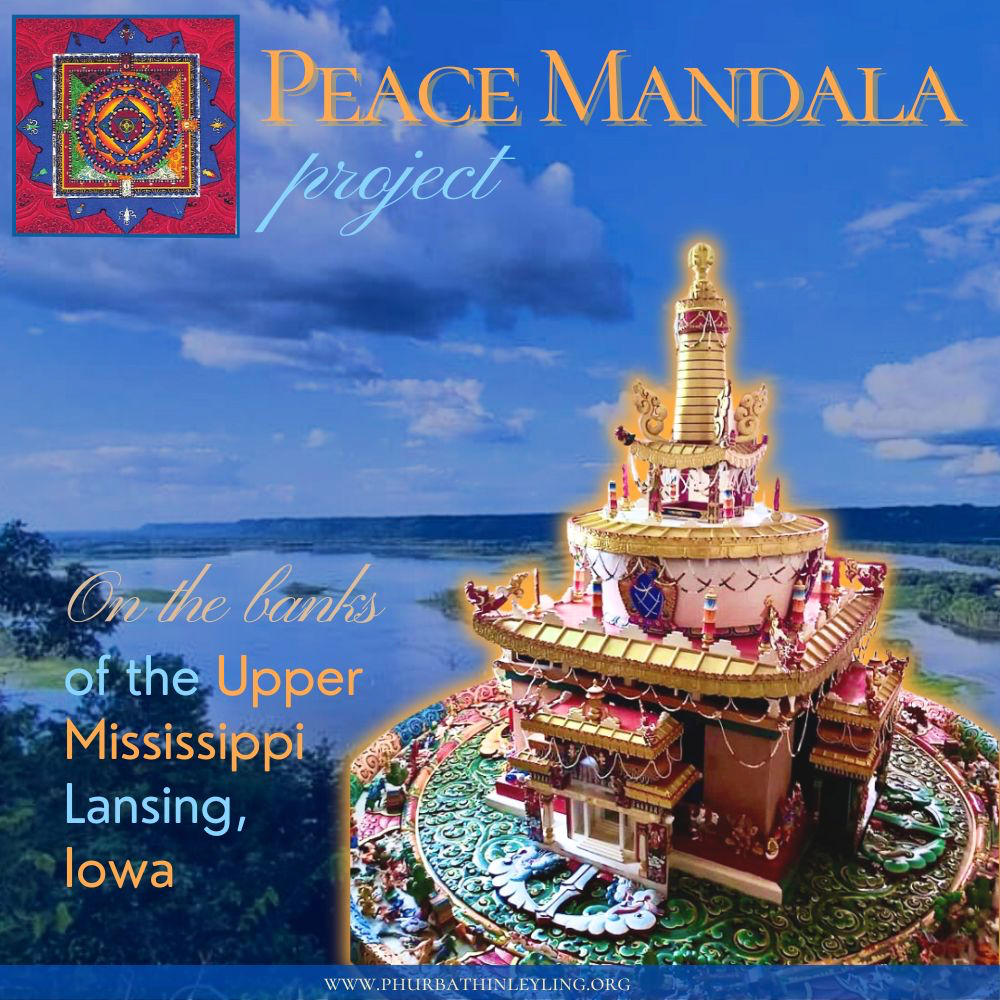
Previous episodes with Khandro Kunzang:
Elemental Spirits, Vajra Armor & Dharma Marriage
Lineage of Oral Instruction, Real Teachers & Himalayan Yogas of Tsa lung and Tummo
Cultivating Siddhis, Tukdam, Lineage Protection & Consortship
ROUGH TRANSCRIPT
Please excuse all errors
[00:00:00]
Olivia: I’m Olivia Clementine, and this is Love and Liberation. Today our guest is Khandro Kunzang Dechen Chodron. Khandro Kunzang is a long time Buddhist practitioner and teacher, as well as holder of the Rigzin Sogdrub and Dudjom Tersar lineages.
She is the Executive Director for Saraswati Bhawan and oversees the translations and publications of practice texts available on Saraswati Publications. Khandro Kunzang leads retreats and teachings worldwide. As well as at Phurba Thinley in Iowa, she also heads the Phurba Peace Mandala Project International.
Khandro Kunzang has been a guest a few times. You can visit the show notes for the links to listen into these [00:01:00] previous conversations.
Thank you so much for meeting today.
I know we had bookmarked, The mandala principle. So we’ll be exploring that today and in connection to the, incredible Vajrakilaya mandala you’re building . So should we just jump into that
Khandro Kunzang: can just jump in. That’s great.
Olivia: Okay. Wonderful.
Khandro Kunzang: For also for allowing me to have this opportunity to talk about this.
Olivia: Ah, such a joy, such a joy. So yeah, maybe we begin then with the basics. So what is the mandala principle?
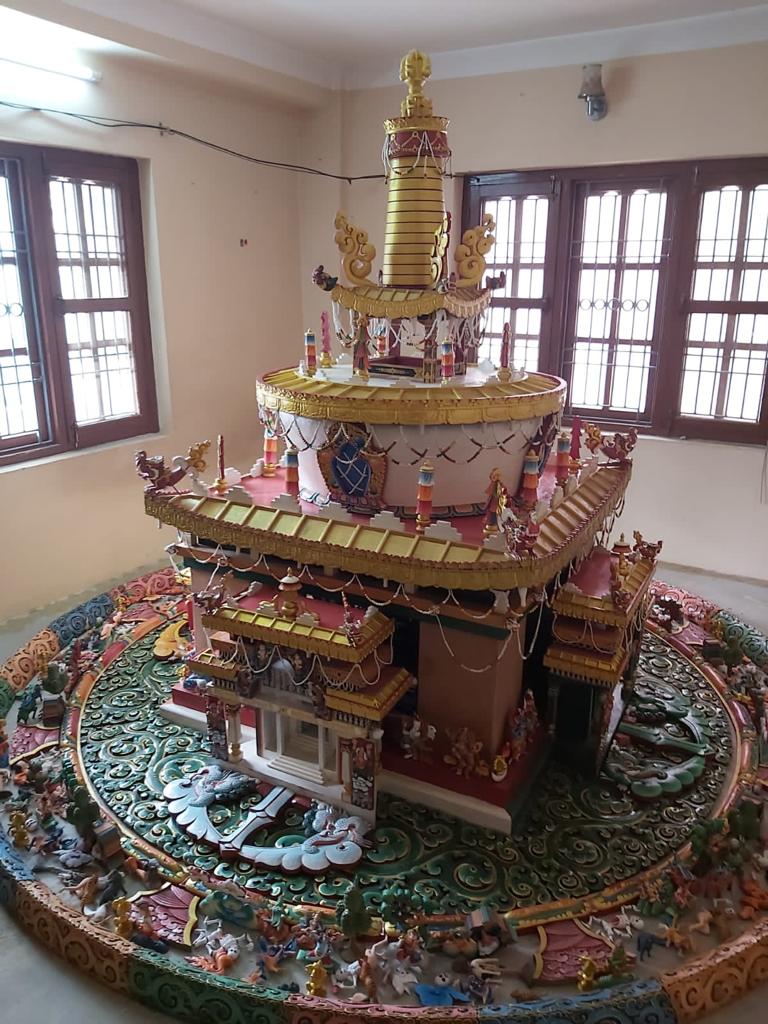
Khandro Kunzang: that’s a great question. What is the mandala principle? You know, I like that because people, most people know mandala images.
When you say mandala, something will come in mind, an image that, you know, has some kind of spherical shape with points in the center and sort of geometric. [00:02:00] designs inside, sort of the symmetrical design. So people kind of know that word mandala now. So I think it might even be in the English dictionary at this point, right?
So they think of an image as a thing, but it really is a principle. It really is a very profound principle that communicates these spiritual, deep spiritual ideas. And so of course, mandala as a principle and a design have existed in a lot of cultures. And, but in particular in the Buddhist, in the Vajrayana Buddhist culture, there they play a prominent role in our spiritual practices and Vajrayana practices.
And, um, a lot of people have witnessed or seen the sand mandalas that, the Tibetan lamas will create as part of their generating a, an enlightened beings. Palace and, and retinue. There’s a whole tradition of making [00:03:00] sand mandalas that are, that are created and then dissipated, you know, as part of the generation and the disillusion phase, but what’s not so commonly known is that there are actually three dimensional mandalas that when we see this image, this round shape with concentric circles and squares and an image, we’re actually kind of looking at an aerial view of a building design.
You know, it’s sort of like the, you know, top down floor plan of a building design of a three dimensional structure. They’re not so common. You, you will find three dimensional mandalas. There are several monasteries in Nepal that have them. They’re usually on the top floor of the monastery. You may not know about them.
You have to sort of find out and go up and view them. Um, there’s some places they’re restricted. You know, you can’t view them unless you’ve had Vajrayana empowerment because they are part of that sacred, uh, [00:04:00] practices. So they’re not so common. Mostly in the West, we’ve seen the pictures, the flat images, paintings, or the sand mandalas.
We have not seen the three dimensional mandalas. And so that’s what we’re doing is we’re creating this three dimensional mandala. And the purpose of that is because there’s the principle Um, in Buddhism of liberation upon seeing, tong drol, that to simply see this sacred geometrical pattern makes an imprint on the mind because it communicates an enlightened mind.
Mandalas are actually like a map of the structure of reality. You know, and so they’re this organizing principle. The principle is this organizing order out of chaos, taking lots of disparate things and organizing them in such a [00:05:00] way through this enlightened order that’s implicit in the universe. It’s sort of a law of the universe, this order.
Ordering principle. We see mandala designs and shapes in nature in the way that flowers unfold or Shells and things like this. It’s a kind of ordering principle of the universe And so when we see an image like this, it communicates something very deep to our mind And these particular kinds of mandalas that are in the Vajrayana, they, there’s something called the palace architecture style that was formed in the 12th and 13th century.
And so they literally are the palace or the abode of an enlightened deity, the, the, the representation of the absolute enlightened nature of mind. As an image of a deity, so there’ll be some kind of deity in the center, and then they’re [00:06:00] manifesting their abode. They’re manifesting their retinues, right?
So things will unfold from the center in this sort of geometric way. Always according to the four directions. So you have this importance of these directions, which all have different qualities. So there’s this unfolding and opening, the retinue, and then the palace structure. And then you have outside the mandala, concentric rings that have different meanings.
So it’s really a, a sort of, um, principle of unfoldment. From a center point, right? So mandalas all have some kind of periphery ring in a spherical shape and some kind of center. So the center rim is sort of, you know, a really basic idea of a mandala structure and then what is sort of forming out of that.
And so, so these ideas of, um, [00:07:00] organizing principles, patterns. Inside and outside, center and periphery, these are all concepts. And yet there is behind that, this ordering principle that is beyond concept. So ultimately, mandalas communicate this idea of unification. It’s the great unification, the great oneness.
All these separate separate things are being unified by some sense of oneness. They’re interdependent. They co emerge and co arise independence on each other. The deity arises independence with their palace, with their retinue. So, It’s a oneness, ultimately, it’s ultimate communication is this principle of non duality and oneness.
So there’s a lot of dimensions being [00:08:00] communicated, very particular things, each part of the mandala has specific meanings and it actually gets very complex. And yet it’s communicating wholeness and oneness. There is this principle behind all of phenomena that is, Connecting it and then on a personal level, it’s communicating this sort of my own self in the center of my experience, because on a personal level, we are also, we’re in the mandala of our own world, you know, so the mandala as a kind of sphere that, that we create, or the sphere of influence, we all have this, and that word is often used in that way, You know, they’ll use that word mandala talking about sort of a Lama and the mandala of students like this, that word is used to sort of describe a sphere of influence.
So we all have this, we’re in the center of this [00:09:00] mandala world that I’m creating with my senses and my cognition. So it’s communicating how our mind works, right? So it’s sort of a map of our mind. of the mind, both on a conceptual level and also on an absolute level. So that’s the purpose of the mandala principle.
And then the mandala structures as they’re either painted or the the sand mandalas, or in our case this three dimensional mandala, there’s, there’s very specific aspects to those, shapes and forms and The various things that are in the mandala that communicate itself a lot of symbolic meanings. So I think that’s sort of the big picture.
Olivia: You spoke about the mandala as a support for practice as well, you mentioned that.
Khandro Kunzang: The mandala as a support for practice has to do with these Vajrayana systems. Sadhanas that are [00:10:00] centered around a deity, right? So in all of the tantric, um, texts in the different lineages, they’re based around some specific deity. And that will be particular to the lineage, whether it’s a Dakini, a feminine principle, whether it’s a Yidam, whether it’s a Guru, you.
There’ll be some kind of deity representation in the very center. Sometimes they’re single. Sometimes they’re in union with a consort. So then they manifest this field of their influence. And so then the shapes of the mandalas, whether the, Inside is going to be a circle, a square, a triangle, has to do with what kind of deity it is.
And then all the other aspects of the mandala. And so that has to do with our sadhana practices. And when we’re involved in the more elaborate forms of generating the deity, they [00:11:00] will have very elaborate descriptions of their You know, so oftentimes we have to visualize this first. We have to, and it’s very, you know, from a seed syllable, this arises and this arises.
And we construct the environment. And then finally the deity is arising in the center of it. These are the elaborate forms of sadhana practice. And, You know, a lot of times what we are exposed to in the West are the very short forms of sadhana practice that’s only focused on the deity. So they’ll just be the deity visualization, but not all this other elaboration.
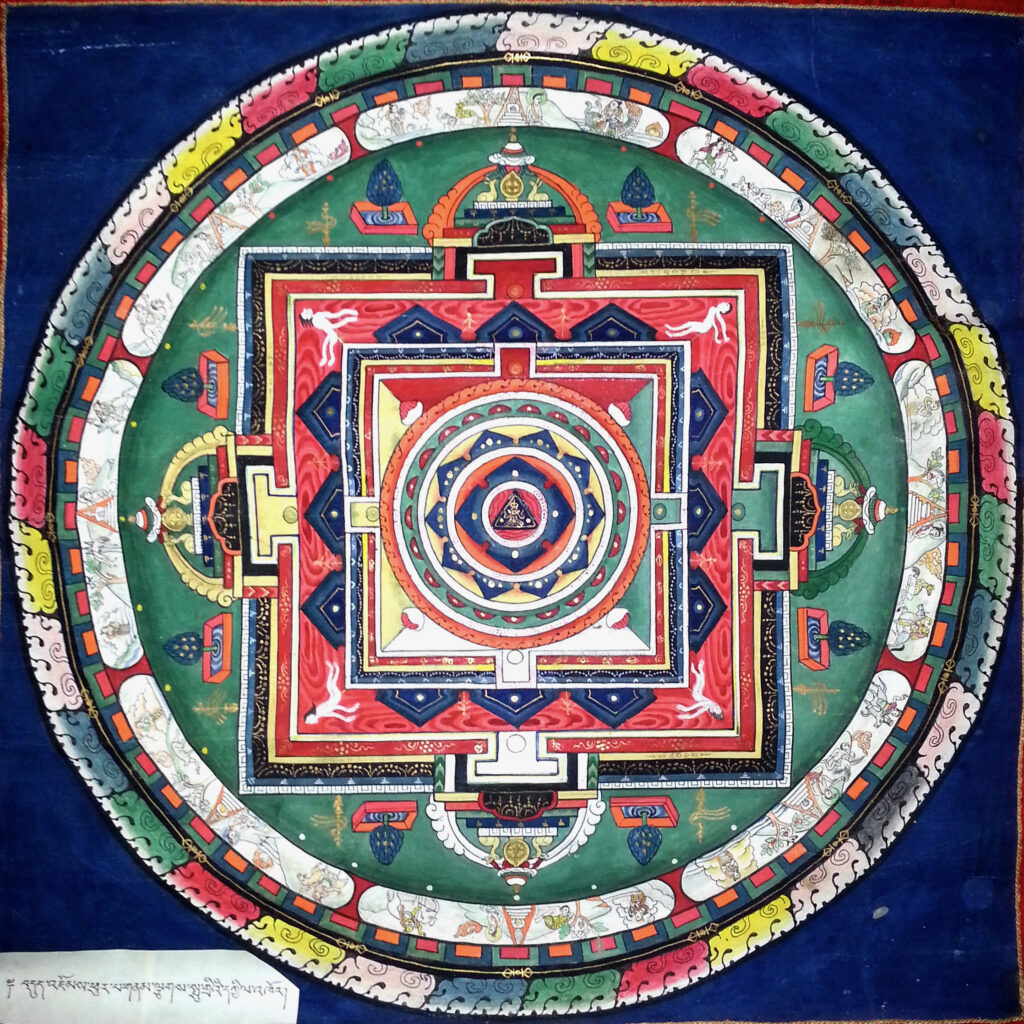
Vajrakilaya mandala
So, but if you’re participating in drupchens, for example, the full retreat sadhana, you’re going to encounter these elaborate Uh, descriptions of the mandala and they were that’s when they will construct these mandalas when they’re doing these types of great accomplishment [00:12:00] rituals that it’ll either be a sand mandala or they’ll have an already constructed mandala that is the center of the practice.
And then, you know, that’s used as the support for the visualization. So they are ultimately when you become more deeply immersed in the traditions of whatever lineage you’re doing and whatever deity you’re practicing, you’re going to encounter the, the, the long form of that particular sadhana cycle. And there will be the description of their palace and the mandala that you are then to, to visualize.
And so at that time you learn about all the different the components of the mandala and what they mean and then you’re meditating on that you’re meditating on these meanings as you’re generating it in your mind and then the deity in the very center of this and so it’s kind of like a journey you know the mandala we we begin at the [00:13:00] periphery you know the outermost which is this ring of fire right that’s that’s the wisdom that’s going to burn all the ignorance and then we enter in and we go in These concentric levels, the ring of fire, once we pass the ring of fire, then we, then there’s the ring of the Vajras that represents the indestructible mind.
And then we, if it’s a wrathful deity, then we encounter this ring of charnel grounds. This is a very interesting aspect of wrathful mandalas. These eight charnel grounds that represent the eight Aspects of consciousness, the five senses and the three levels of, of conceptual mind. And, and they represent our, the, the boneyard of our existence, of our current samsaric existence.
And the, all the ignorance and all the, The poisons that cause us to be in Samsara. So that’s on the very outer ring is our sort of, the remains of our, [00:14:00] of our, our existence in our many lives. And each of these charnel grounds, they have, Different, different figures in them. They have stupas and sadhus meditating.
Then they also have lots of skeletons and body parts and wild animals and trees and Nagas, you know, they have like this whole world, you know, like a diorama, you know, each one of these has all these figures in them and they represent each of the eight consciousnesses, right? So, so then that’s the world we’re in.
And then we pass through the ring of the lotuses. Which is sort of like our rebirth and renewal. And from there we enter into the sacred ground of the deity. There we start entering into the palace. Beginning with the four gates that are in these four directions. That represent the elements. There are different colors and We have to enter into one of the gates, right?
And there’ll be the protectors. All the protectors will be there. [00:15:00] And then the, the gate guardians, we have to pass through the gate guardian. So it’s like this kind of purification by fire until we can enter into the inner sanctum of the deity. You know, whatever deity that is.
And in the case of the mandala we’re building, we’re building this Vajrakilaya mandala.
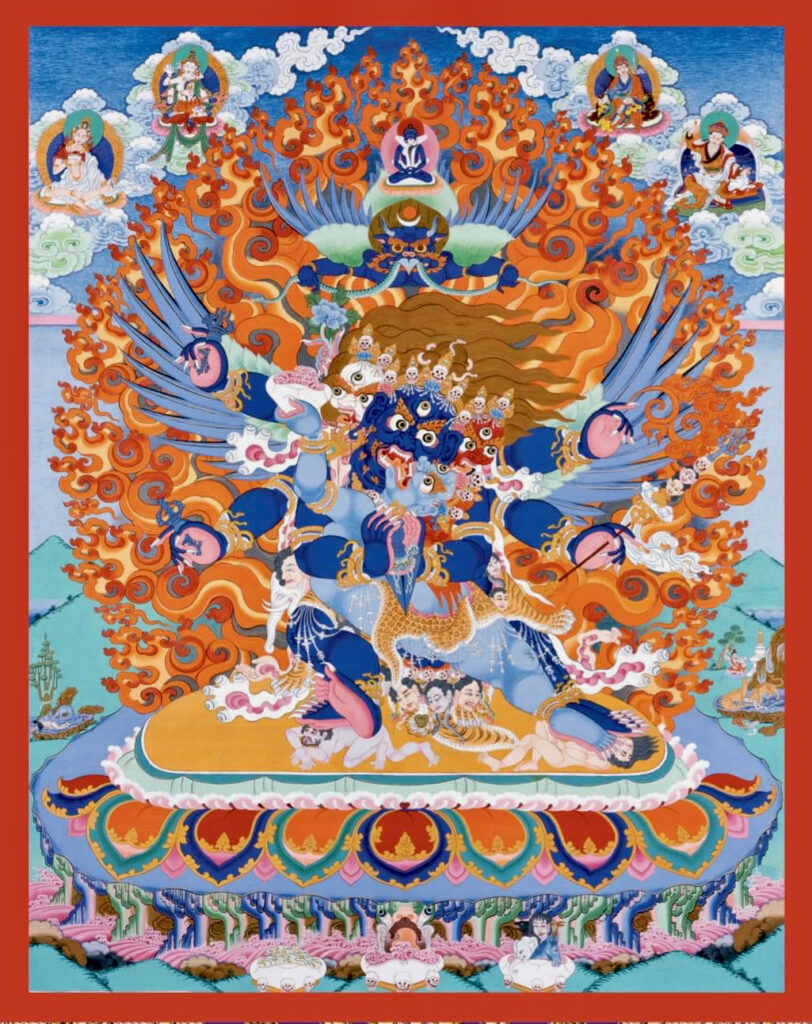
Vajrakilaya thangka
So that’s very particular to this Yidam that’s in our tradition, the Dudjom lineage, main Yidam is Vajrakilaya, very wrathful, um. deity, and Vajrakilaya has their retinue. So Vajrakilaya Mandala has all these, the central deity are in these purba shapes, dagger shapes with the heads and the wings. In the center, Vajrakilaya with his two consorts.
And then, and then it sort of refracts the five buddha families, you know, from there. There’s another level, the top level [00:16:00] is the main deity. Then there’s another level where you have the five Buddha families. And then there’s another level where you have the 10 Herukas and their consorts, and each have two progeny.
And then another level is the 21 sons. And then another level. You know, you get these levels of manifestation that grow out of this central point, and they all have a function, and they all serve a purpose, so you have to learn about these as you’re learning about the, this particular sadhana of Vajrakilaya.
What, what’s the purpose? What do each of these deities look like? What is their function? What is their enlightened quality? They’re all aspects of enlightened quality. So the Vajrakilaya Mandala inside the palace are going to be this sort of array of these different phurbas that have different heads, animal heads, and um, they’re all carved out of wood in this particular and that’s inside the palace.
So other [00:17:00] deed, you know, other mandalas will have other deities inside and how they will be arrayed will be particular to that sadhana cycle. So that’s going to be different for the different deities. Otherwise they all have this sort of concentric ring of the fire and the vajras and the lotus. and the palace with the four doors.
They all sort of share that type of structure. But then, you know, then whether they have charnel grounds or not, whether they’re wrathful or not, um, and inside the inner sanctum, what specifically is there. So as we’re doing these practices, it’s like a journey from the outer rim into the center where then Ultimately, we become this.
This is, you know, we become the deity, and this becomes our manifestation. That’s the, the skillful means, right? These are all skillful means of working with our own mind to show us our own true [00:18:00] Buddha nature by using this methodology. So, so it’s like a journey. you know, as we, as we use the mandala. So the mandala becomes a support, a visual support for this journey, this meditative journey that we’re going into the innermost, innermost aspect of our own buddha nature, ultimately.
So that’s how it’s used as far as, you know, practice. And, but these mandalas also serve another purpose, as a kind of field of blessing. So, and this is where we get into sort of the project that we’re doing, that Lama Dawa, you know, conceived of many years ago. Because they’re, They’re considered a powerful source of blessings in the same way that stupas are, right?
So stupas are much more common now, and in the West we see many, many stupas being constructed. they have a geometric form, very specific [00:19:00] sacred geometry. They’re filled with many amazing things, and they themselves become this field of blessing that profoundly influences people.
It’s the surrounding areas in a beneficial way that profoundly influenced the essences of the elements. And so constructing a three dimensional mandala has a very similar benefit. So wherever these mandalas are constructed, their benefits extend out into all directions of space, all dimensions of time.
and bless the fundamental elements. And so then you have, well, what kind of mandala is it? What is the deity? What is the deity’s quality, right? So the deities have different qualities. There are some are peaceful, some are enriching, some are empowering, and some are wrathful, according to the four activities. [00:20:00] And in this case, this is Vajrakilaya, very wrathful.
deity and, you know, Lama Dawa had many visions or inspired downloads, you could say, from his protectors and, and from his gurus that we need to construct Vajrakilaya mandalas in very particular places, three particular places. Why Vajrakilaya? Because Vajrakilaya is the, Most powerful way to undercut negativity, conflict and warfare, right?
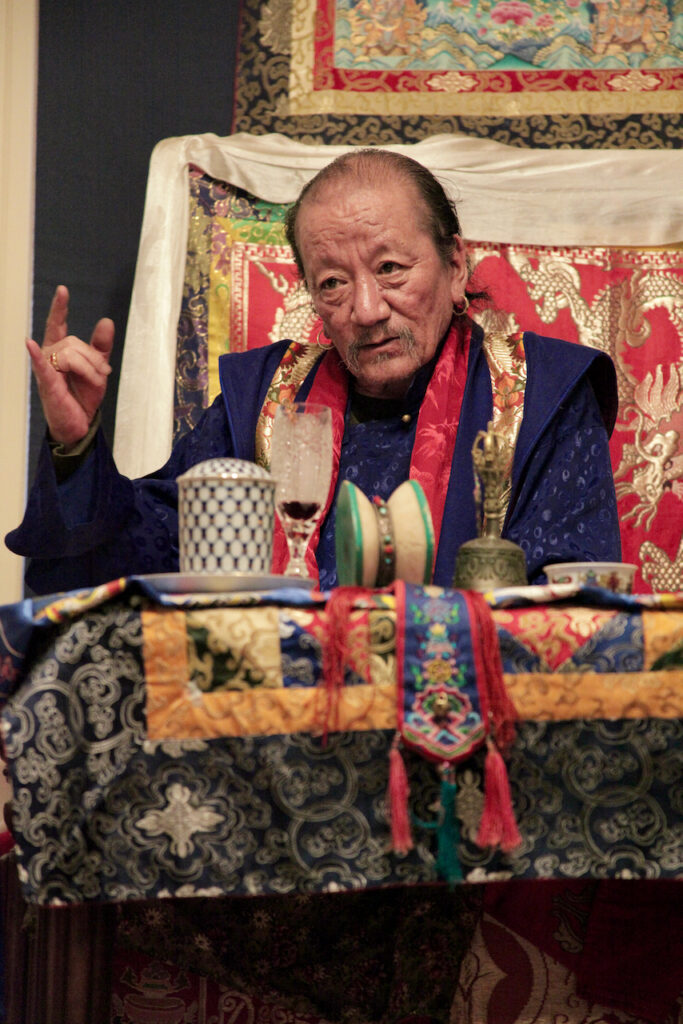
Lama Dawa teaching
So this goes into many of the prophetic things that Lama Dawa saw in the future. More and more conflict, more and more global warfare, as of course, which is exactly what we’re seeing, but it’s also in accordance with the prophecies of Guru Rinpoche. And in particular, there’s a text by Dudjom Lingpa that he [00:21:00] wrote, um, called the Kilaya Kajang, which is the prophetic guide to the 17 activities of Vajrakilaya, where it, it’s a terma, revelation, And in this terma revelation Guru Rinpoche are having this conversation and this is after he has given Vajrakilaya teachings and now he’s um, instructing Yeshe Tsogyal that these teachings need to be hidden as Termas.
And then she’s asking him a series of questions of when these are revealed in the future what will the world be like? What will the signs be for, for when these teachings need to be manifest in the future? And so he then Gives us long list of, you know, future predictions of all the calamities that we’re going to be facing and all the, the, the background causes of them.
And then the different, reincarnations of Territons that are going to manifest at different times. And the most effective practice [00:22:00] will be Vajrakilaya. So it speaks of the importance of Vajrakilaya at this time. You know, and he goes on to say that it’s, you know, there’s no other method other than Vajrakilaya to avert this kind of negativity and danger.
So based on the prophecies and based on the prophecies of Guru Rinpoche and then in particular in the Dudjom lineage of Dudjom Lingpa. Lama Dawa felt through his own inspired vision that this is, this would be very, very beneficial to build these mandalas. Of course, we do Vajrakilaya practice, you know, doing the practice is part of it.
But the other part of these spiritual traditions are these kinds of monumental structures that serve to benefit in particular ways. So therefore stupas are well known, but mandalas also have the same kind of benefit that to construct a mandala in a, [00:23:00] in particular places that can optimize the blessings will have profound energetic benefits that can help to mitigate and undercut the levels of Of anger and violence and stuff that’s on the rise.
So this is part of his aspiration he had for many years. And of course, because Lama Dawa does mirror divinations, you know, he got many guidance from mirror divinations about location, etc. And finally, it was settled. On this location that I’m involved in in Iowa, Northeast Iowa on the banks of the Mississippi River.
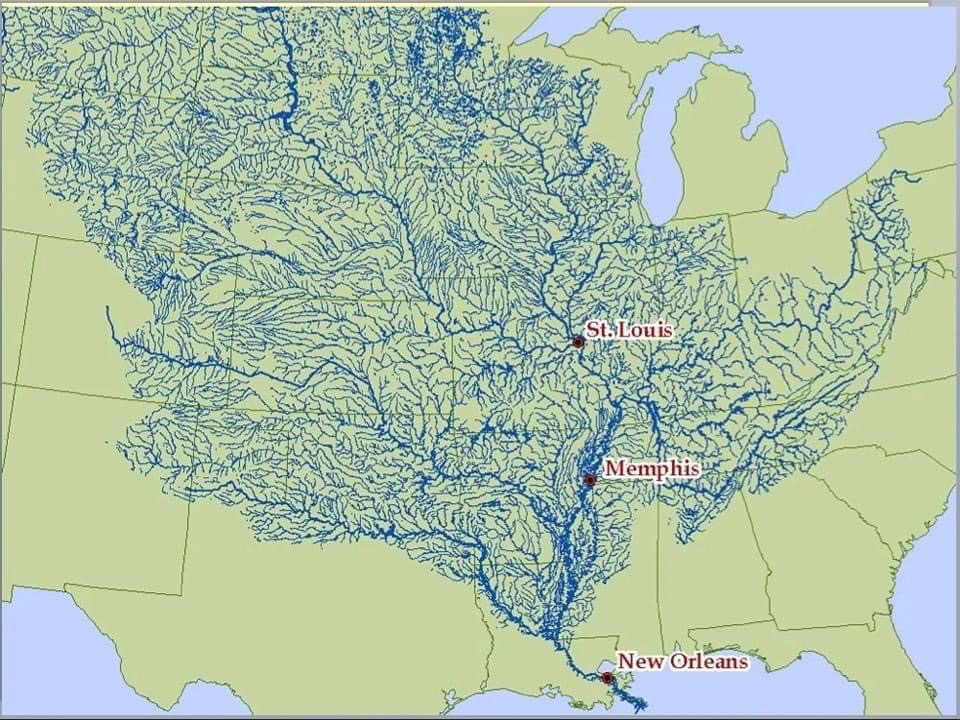
Watershed of the MIssissippi
That was seen as a very, very auspicious place because it’s on the central channel of the of North America. The Mississippi River is the central channel. Three quarters of North America drains into the Mississippi River. Mississippi River, which goes into the Gulf of Mexico. [00:24:00] But not only that, when, when we went up to that area to see the area, Lama Dawa had many, many visitations by the local spirits and the Nagini of the river.
It, because it was very alive there, and come to find out. There was all these Native American effigies that were there created 2, 000 years ago that still existed on the bluffs of the Mississippi River Valley, that that area of the Mississippi River is very beautiful. It’s actually now a federal fish and wildlife reserve.
Refuge, 260 miles stretch, and on there’s thousand foot high bluffs on either side of the river valley, which is three miles wide with rivers and islands and lakes. It’s incredible are these Native American mounds that are in the shape of animals, that are in the shape of snakes and birds, [00:25:00] that are 2, 000 years old.
And some of them have been preserved. There’s a federal park in Iowa called the Effigy Mounds National Monument that has preserved them. Most of them were destroyed by the European farmers that came in and, and turned the prairie and the area into farmland. So they didn’t know what they were doing. were so but some of them have been preserved and so lo and behold, the Native Americans also recognized this area as a powerful place.
They built, these effigies were, they think they were used for ceremonial purposes. There are some that have Human remains in them. So some of them were burial mounds, but many of them were not and they think they were The Native Americans went up to these bluffs to do ceremony like this So Lama Dawa had many visitations when we went to the area and we realized oh my gosh, you know if we could find property Here on the bluffs [00:26:00] overlooking the Mississippi River, and particularly on the Iowa side, because then it’s facing east, right?
So this eastward facing was very important for Vajrakilaya, which is Vajra family from the eastern direction. That was a very important geomag, geocentric aspect that needed to be there. And the other thing that needed to be on a major body of water. So that the water carries the blessings down, and in this case, down to the Gulf of Mexico and then can spread out throughout the whole world.
So what’s the vehicle of transfer of these blessings? And in this case, the water element, again, the Vajra family. Water element, you know, some are fire elements, some are air elements like this. In this case, it had to do with the water element. So all these factors come into play. And so we did, we found this.
beautiful property [00:27:00] that was just put on the market right on a bluff. It’s very difficult to find these kind of properties there. And um, yeah, so, and so there’s the Iowa property. And then at the same time in Mexico, he had similar experience in central Mexico near this volcanic mountain, Popocatapetl, very sacred mountain.
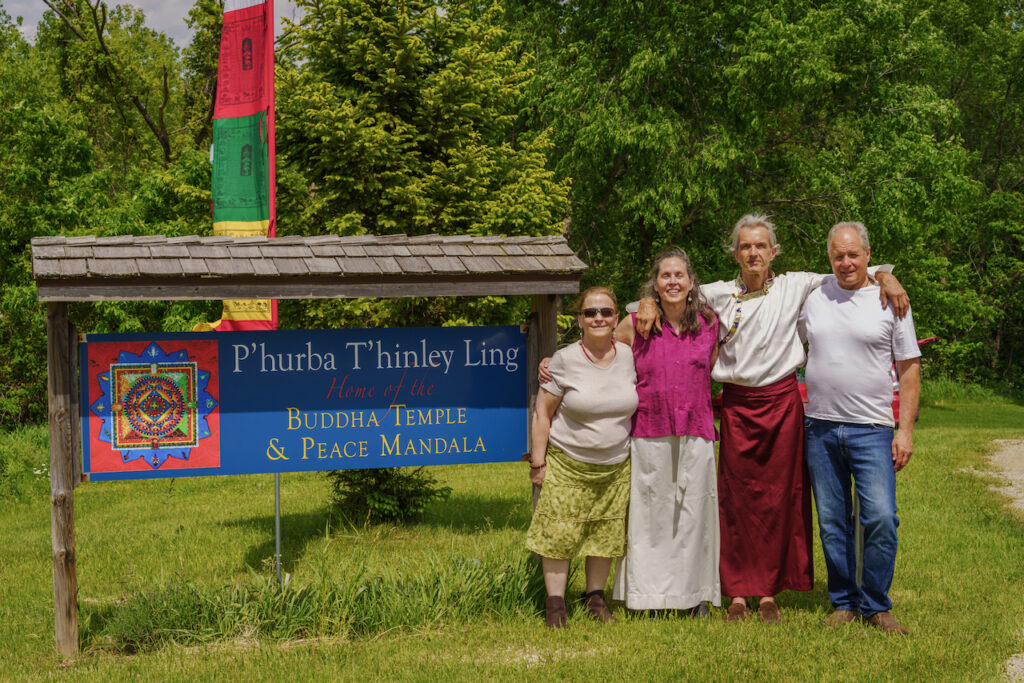
And active volcano, one of the most dangerous volcanoes in the world. It’s a caldera underneath it. And there’s Mexico city, 20 million people nearby. And he had many visions of the, the God of the mountain, the Lha of the mountain, just like the Lha of the Mississippi River, the Nagini came to him, in this case, the spirit of the mountain came to him, and, um, and so he saw that there needs to be also a mandala constructed and installed near the base of this volcanic mountain, [00:28:00] and that would have to do with a fire element.
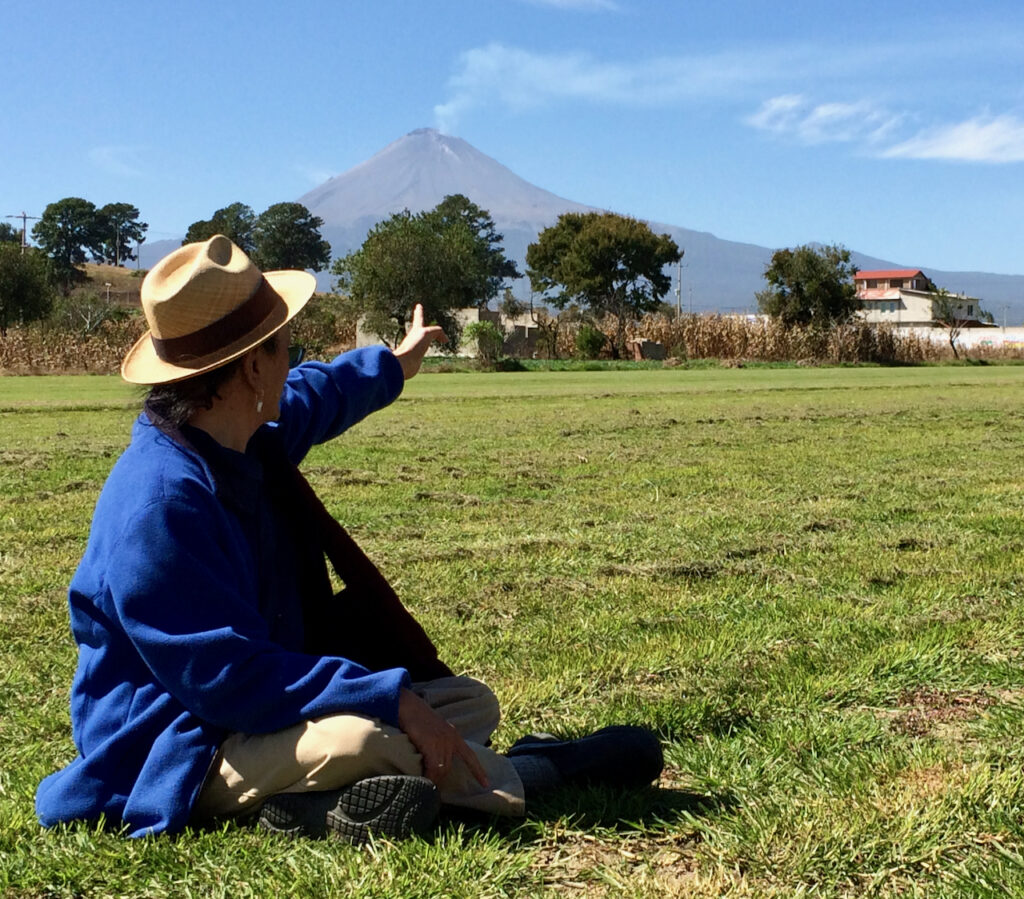
Lama Dawa looking at land in Mexico, pointing to the volcano
Right. So the Mississippi is working with a water element. This is working with a fire element. And then the third mandala was to be in Pharping in Nepal, in Yanglesho, where Guru Rinpoche first practiced Vajrakilaya and started to disseminate this cycle. And so, um, that will be. According to the earth element.
So we’ve been working on this project for many years and now the mandala for Iowa was finished in 2020. We, we managed to ship it back as the world was shutting down with this pandemic. That was pretty wild. And last year, no earlier this year, the Mexico mandala was finished and is now in storage in Mexico City.
And the Nepal mandala is currently being worked on. And that’s going to be installed at the Dudjom Yangsi monastery in Pharping. So we already have [00:29:00] pre arranged that they are going to build the, the building for it and install this in Yanglesho. So that’s, that was his vision, and it had to do with the prophecies of Guru Rinpoche, of Dudjom Lingpa, the importance of Vajrakilaya, and what we can do to, you know, as practitioners, of course, we have our practices, but this is also an aspect of the practices is to create these kind of Structures that are there long after we’re gone that have their own beneficial effects to pacify, to enrich, to empower, and to subjugate.
In this case, to subjugate.
Olivia: I’m, I’m curious how the mandala allows the elements to be pacified, the mandala itself and those four directions, like what is that relationship?
Khandro Kunzang: Well, the, the structure of these sacred [00:30:00] structures, they themselves have the power to, to bless because of their design, because of the materials they’re made out of, and because they become consecrated, like when you consecrate a stupa or you consecrate a mandala, the deity becomes installed. in there like there’s a special ritual that you install even statues like all the statues that you see they’re filled with things mantras and then there’s a consecration where this energy is installed so they themselves they work without doing anything, right?
They, their presence, because of the, the form, they have a special form according to the rules of how they’re made, the dimensions, the, the sacred geometry, the materials that are used are very special. materials. They’re done according to the text exactly and then they’re consecrated. [00:31:00] And so they, they give off a field of blessings that’s going to permeate all of the elements.
And then if they’re placed in a particular spot where there’s an element that’s very powerful, like in this case, the Mississippi River, that’ll sort of be the dominant vehicle or next to the Popocatépetl, which is a volcano. And those, those are sort of the exterior forms of elements, but elements all also have a subtle level, right?
So the, the four directions also communicate these elements, right? So the five elements in this system is space and space is usually in the center, right? And from the space radiates the other four elements, air, water, fire, and earth, right? So, and they have to do with the different directions, right? East is water, west is fire, north is air, and south is [00:32:00] earth, like this.
And, um, you know, so you have this idea of from the void, or from the absolute nature of space, Then, the first manifestation forms. Form comes from this emptiness, right? And it starts in this very subtle level of the subtle elements. And they have different colors that signify these subtle aspects. And that coalesces, coalesces, solidifies, solidifies to form the physical elements that make up the world that we know, that we can touch and feel and see.
Smell and see and hear and, and our bodies also have these, these five elements. The solidity of our bones is the earth element. The blood and lymph is the water element. The heat of our body is the fire element. The breath and movement is the air element. And our thinking consciousness is the space element, [00:33:00] right?
So everything is made of. The elements, and they’ll talk about the mother element and the child elements, right? So from the mother elements, we are the child elements, right? So there’s this process of, of generation, right? This, this, um, creation process that begins from this absolute void. And so the mandala represents this unfolding of this creation process.
It’s a, it’s a, Representation of the symbolic representation of it, and so therefore it has an impact on the subtle moving into the physical world, right? So on the physical world, then the Water elements, so there’s the river, but there’s a subtle element to that river, too. It’s not just the water that we can feel and see.
There’s subtle, behind, behind that appearance, there’s a subtle realm of that water element. But it’s very dominant there, right? Water element, [00:34:00] Naga, it’s a place where there’s a lot of Naga energy. Right, so a volcanic mountain, this fire element, it’s sort of dominant. And so the types of spirits, for example, are going to be the Tsen, these kind of spirits that live in the world of fire.
And this has to do with the non physical beings that are recognized in the Tibetan Buddhist world. And many of them are protectors, you know, many of them are the kind, different kinds of Dharma protectors. And their, their abode are these elements in their subtle form. And so these structures have the effect, you could say, of balancing the elements or strengthening the elements, purifying the elements.
Um, you know, they help to repair the damage that we humans have made on the elements because we’re destroying the elements. You know, and [00:35:00] as we destroy the The physical nature of, of water or the physical nature of Earth, the subtle realms are disrupted, and it becomes very disruptive to the spirits. And as the spirits become agitated and disruptive, it then, the blowback is on us humans.
Right, so the way that, um, The way that the ancient texts talk about, like when Guru Rinpoche talks about these prophecies and he talks about how in the future, there’s going to be more and more wars, you know, what’s what’s behind that? You know, what’s the cause of that? Well, the cause of it is the constant non virtue that humans are doing, the constant destruction that we’re doing, and as we destroy the environment, the spirits are disturbed, and then people’s minds are disturbed, and people want to fight all the time.
You know, it’s, there is this symbiotic relationship that mostly in the West we are, we are [00:36:00] clueless about. And, you know, but our actions And, um, the things that we are doing on the planet, mostly for our own personal gain, right? For, uh, we’re, we’re not taking any consideration that the things that we do, the earth that we dig and mine and, um, you know, the garbage that we produce and the fires that we make and the smoke that we produce are having effects on these subtle realms that are also sentient.
That also are becoming sick, and they’re, and that’s affecting us because we have this co dependent arising, right? We have this law of interdependence, which is a law that the Mandala communicates. It communicates this co emergent arising. And so, um, and so therefore, the prophecies say we will have more diseases.
Every time we have war, a new [00:37:00] disease pops up. And lo and behold, we have these really strange, like, pandemics that pop up seemingly out of nowhere. But there are backgrounds to this. Right, so the human beings suffer more. We have more diseases. We have more calamities. We have more misfortune. Our economy goes down.
Our young energy and prosperity energy gets destroyed more and more. You know, and so there’s this, this cycle that we’re on, this very negative destructive cycle, and that we are playing a big role in it. And so these structures help to pacify, to bring some realignment. on these subtle realms to pacify the spirits.
When the spirits are pacified, then we can feel more peace as well. You know, when the spirits are happy, we experience more prosperity, right? So, so these kind of [00:38:00] structures and the rituals that are done around them, because there’s also now the practices that are done in accordance with these mandalas.
have profound effects on all of these subtle realms, which has profound effects on all the beings living on those subtle realms. and that will bleed over into the human realm. You know for example, just as a personal example of my own observation, in the little teeny town that we live in in Lansing, Iowa you know?
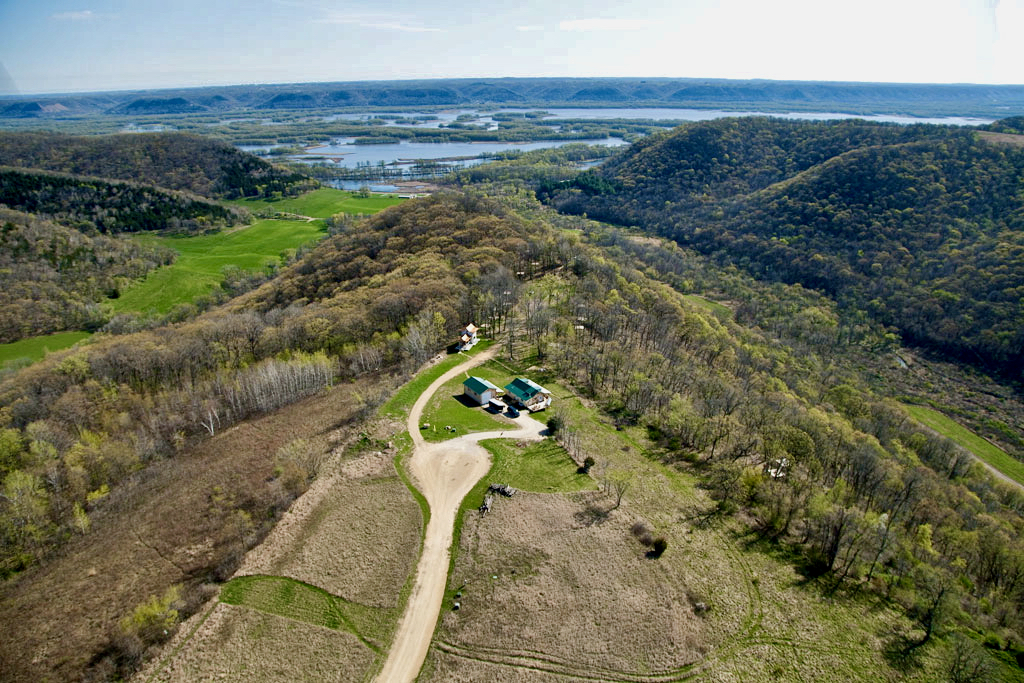
Aerial view of Phurba Thinley Ling land and Mississippi
There’s a thousand people that live there. It’s a little, small, river town that we moved in 2007. in. Right, so we’ve been there for quite some time, and, and this little town, always, I notice the businesses are always struggling, like every year, somebody goes out of business and some new business starts there, you know, and what I’ve noticed since we have built our stupa, and since we installed a Buddha, is that the [00:39:00] prosperity of the town is increasing.
You know, it’s becoming a kind of vibrant little town. Of course, there’s a lot of people in the town who are also trying to make this happen. But behind that, there has to be an energetic quality to draw that, to draw these people, to inspire these people. There’s more and more interesting people moving into our area and bringing all kinds of Arts and all kinds of events that enrich the area.
This is what I’ve noticed since we Buddhists have been up on the bluffs quietly doing our things. I like to think that we’ve played a part in bringing enrichment and prosperity to our little, our little neck of the woods. Although, you know, I wouldn’t go bragging this to the local people, but I believe that to be true because I’ve seen, you know, similar things like why do some towns prosper and some towns don’t?
You know, why do some businesses, [00:40:00] you just see one after another, they just can’t make it work. Why? That has to do with energy of the spot. That has to do with, um, sort of invisible dynamics that are there that generally in the West were not. We’re not cognizant of, you know, so we’re working to, we work on that level.
All these activities that we do, the structures of the mandala, the stupas, the practices, are working on this level and it’s having, that’s where the beneficial effects come in. You know, they’re, they’re not necessarily overtly physical effects, although you can feel the effects and you can sometimes feel them very quickly, but it’s something that sort of over time pervades and grows and you start to see these different changes in these different positive qualities, right?
So that’s how it’s understood. It’s understood to work that way. Um, and it works on these [00:41:00] subtle elemental realms, which then kind of Show up, if eventually in, in the physical elemental realms or that we can observe with our five senses, like
Olivia: this, I so value your ability to articulate the interplay of all of these levels,
so the mandala, everything arises from the center is what you shared. And there’s this exchange between the center and the periphery as long as we nurture the center the periphery is supported. how does it look like to nurture the essence, on both an everyday practical level and then in our own, in our own path as practitioners?
Khandro Kunzang: That is the, what we are practicing, whatever our practice is. You know, and of course, I’m speaking from the context of a Vajrayana Buddhist path where, where it’s a path, right, that begins with a, some kind of preliminary practice. And then we receive empowerment to start engaging in a sadhana practice according to the [00:42:00] lineage.
And so that becomes our method to introduce our own Buddha. nature to experience that. And once we start having the taste of that and we get confidence in that, you know, that’s, that’s the point, the point of the practices and the blessings that we receive from the lineages. So they have to have this lineage base.
We have a teacher guiding us. We’re employing these spiritual technologies and hopefully going into retreats because it really does require that you have made time in your life. You’ve. kind of, you know, prioritize your time that you’re dedicating to these methods and the blessings of the lineage and the teacher co mingle with your own innate buddha awareness and that starts to arise and it comes in glimpses and then you become more and more familiar with it and more confident so that then you go out into the world [00:43:00] and you can stay in this sense without being distracted, right?
That becomes the practice. How to maintain this is your practice, you know, and that has to do with your vows. Right? There’s always vows and samayas that become essential. Actually, that’s the main practice becomes, you know, practicing your vows to, to, to keep coming back to this, right? Because they’re, you know, we don’t want to go back to the bone yard of our charnel grounds, right?
That we, But it’s going to be in and out and in and out and in and out and in and out. So how do we come back to the center? We come back to the center by re engaging with the practices we were given and by the vows that we’ve taken. You know, so we have to constantly strengthen those vows. We have to constantly find ways to inspire ourselves, um, whether it’s reading, study, sitting at the feet of the [00:44:00] masters.
Going on pilgrimage like I’m about to do to go to the actual places where Buddha was that brings these Stories to life. It’s very important part There’s all these ways to keep us in the path so that we can continue to develop this and ultimately have confidence in it that it becomes stabilized in the face of all the stuff in the world, we become more and more able to maintain that center.
So all the methods that we’re given are, are the ways that we do this. And, you know, so we have to, it has to be important enough for us to want to do this and to sort of create a lifestyle that allows us to do that.
Olivia: And so in terms of this Vajrakilaya mandala, what’s the method then for these particular mandalas for empowering the [00:45:00] mandalas?
Will the community then be doing regular practice daily or annual?
Khandro Kunzang: All of that. I mean, next year we’re building the temple, right? So we’re right now talking to architects. And, and by the way, we’re going to be using, we’ve hired a Vastu architect who does Vastu design, um, from the Maharishi community in Iowa, because they build all their buildings.
And that’s itself a mandala from the Vedic idea. They build their, their buildings according to the mandala principles. So we thought, Well, this we’re going to do this. So we’re right now working with a vastu architect and coming up with the final design ideas and we’ll start bill. We have now we have a sponsor, you know, for many years we’ve been on this fundraising journey.
Now we have a grant and a sponsor will start building. So after the construction, then the mandala has to be installed and that is done. in the ritual. So we have to invite Lama, and I’ve already been speaking with Gyepa [00:46:00] Rinpoche , I met with him in Germany in September. He’s the one I have in mind that I would really like for him to come with some of his Lamas to, to, then they, like a sand mandala is a ritual way of constructing it.
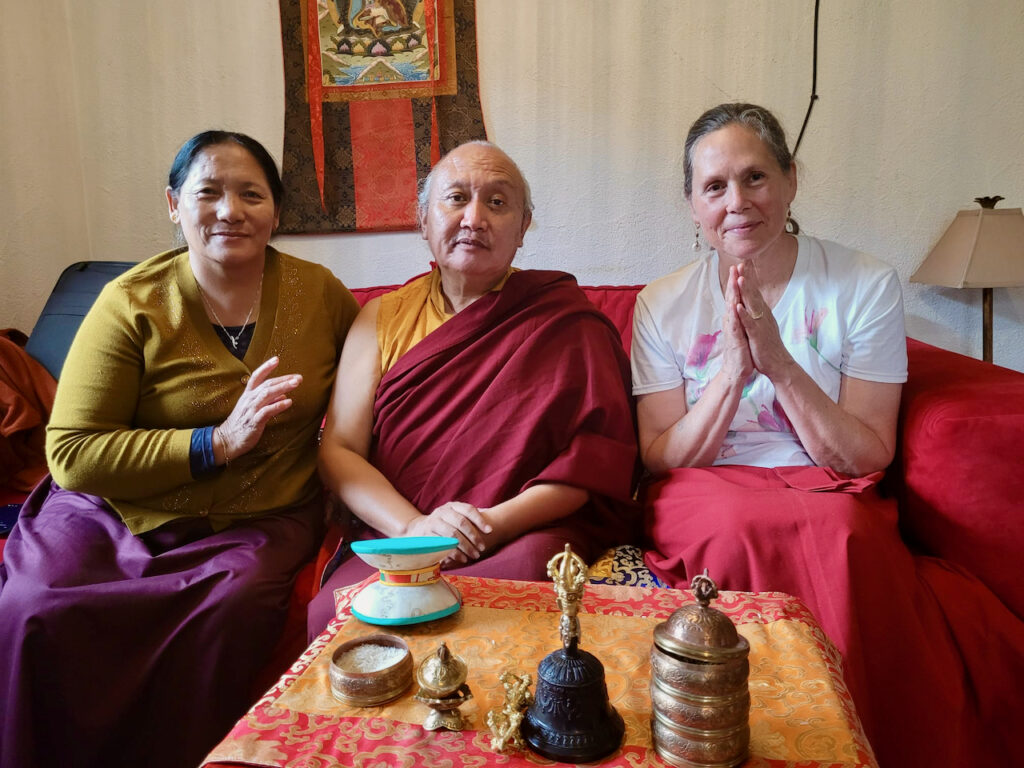
With Gyepa Rinpoche
These three dimensional mandalas are also have to be put in according to the sadhana, so they’ll be engaged in the sadhana practice as they place each of the phurbas and as they construct the mandala. So it’s built and created in the context of sadhana practice, and that’s probably at least a week, a week of ongoing rituals with lamas that we will invite, and then that gets installed and stabilized.
So that’s the consecration. They have to be consecrated according to this, in our case, this Namchak Putri Vajrakilaya cycle of Dudjom Lingpa. After that, then yes, it becomes, you [00:47:00] know, one of our main practices is Vajrakilaya. You know, it is, it’s one of my main practices. So yes, it will be a place where then, um, people can come and engage in Vajrakilaya drupchens, periodic drupchens or drupchos, as intensive practices as the Sangha.
Absolutely. I mean, it helps us to develop this practice and it also, we can re consecrate, you know, it keeps, it keeps bringing the energy in to the sacred space with this mandala and just, um, empower, continues to empower it. So it’s, it’s becomes this, again, this symbiotic, we are benefiting from it. It’s benefiting our practice.
And at the same time, we’re infusing this with this blessing energy of the lineage.
Olivia: and why this particular Rinpoche from Germany, do you feel would be perfect for this?
Khandro Kunzang: Um, he has a very good connection with Lama Dawa. He actually presided over Lama [00:48:00] Dawa’s cremation and he’s the holder of the Namkha Khyung Dzong school of Dudjom Lingpa.
And their, their specialty is actually Troma, the Töluk school of Troma, but Vajrakilaya. The Dudjom Lingpa, he, the first Dudjom Rinpoche cycle, they are really experts in Dudjom Lingpa’s, works. And so, um, Because he has such a good connection with Lama Dawa and we actually, I invited him to come out in 2020 when I was in Nepal and I participated in their drupchen, their Troma drupchen, in his monastery and at that time made, invited him to come to our center, which he agreed to do.
He was going to come in September of 2020, but of course it was all canceled because of COVID. Right. So I had already made this connection. He and his brothers who are all um, lineage holders of this Namkha Khyung Dzong School have a very good connection with Lama Dawa. Right. So it’s, it’s somebody that Lama [00:49:00] Dawa would have trusted.
This is my, my decisions are based on, um, on things like this. That’s going to be. Dependent on being able to get them all visas, maybe up the Vajrakilaya practice, Yes, yes, we will be doing lots of protector practices to pave the way for this.
Olivia: Yeah. Yeah. And I’m actually curious because so you’ve done a Vajrakilaya Tsalung and you, you know, you said that one of your main practices is Vajrakilaya. So for you personally, when you think of prior to being such a devoted Vajrakilaya practitioner to after, what have you noticed for yourself? of making this connection.
Khandro Kunzang: Of that practice?
Olivia: Yeah, just like the relationship even with Vajrakilaya.
Khandro Kunzang: Yeah, I mean, it’s, it was a practice I had to work up to. You know, first I did Dakini practice, peaceful, Yeshe Tsogyal practice. Then after that, I did [00:50:00] the guru practice of Yabyum, and then I did this wrathful practice. That was my guru’s instruction to me, you know, like, nope, you’ve got to, you know, you’ve got a lot of purifying to do before you can handle this kind of energy, because it is very intense.
Wrathful deities are, basically, it’s an intensification. That’s, that’s what we mean by wrathful. Vajrakali is actually wrathful vajrasattva.
You know, Vajrasattva is the essence of Vajrasattva, this beautiful, peaceful deity, but in their, you know, take action right now mode. So then they’re wrathful. So there’s swift results.
There can be lots of upheavals and disruptions, you know, like for example, when we were building this Vajrakilaya Mandala in Nepal and on that last in 2020, when I, it was the final stages of being constructed and they put it together for us so I could take pictures. [00:51:00] This wild storm came out of nowhere, just this.
Wicked wind just, it was like amazing. And then again, when it was shipped to the U S in boxes and we had it in storage through the COVID years, and then last year or 2023. We decided, let’s take it out of storage and put it, open it in our yurt, our teaching space. So we unpacked it and we shipped it there.
And this wild storm, lightning, it was wild, just like out of nowhere as we’re unpacking this. So, you know, very, um, strong. effects. So, you know, I had to work my way up to being able to work with those energies because, you know, wrathful practices are, are not beginner practices, actually. Wrathful deities, you know, which is why a lot of times are kind of kept, you could say secret, [00:52:00] it’s not really secret, but it’s just, you know, they can, they can really be a strong, swift cutting through because that’s What it is, the imagery of the phurba, you know, the ritual daggers is to cut through, you know, it’s, it’s sort of the, the last resort.
We’re just going to cut this. And that’s, you know, that can be hard to handle as we all know, if we have a sudden tearing away of something in our lives, you know, that can be a hard thing to handle. Right? So, yeah, yeah. I had to work up to it. But then you come to understand what is the, what is the meaning of wrathfulness?
What does that mean? It’s, it’s really compassion. It’s compassion in action. You know, it’s the kind of compassion that, you know, a mother sees their toddler running into the traffic and they’re, You know, just instant, fast, ferocious, right? It’s not [00:53:00] angry, right? It’s not a, it’s something fast, cutting through, um, as a last resort, right?
So, so people have to be mature to handle this. So, of course, that means, you know, People have done ngondro and , you know, in my case, I, and then Lama Dawa, I also had his students first start with Yeshe Tsogyal, right? So the Yeshe Tsogyal practice to develop wisdom, awareness, and then the guru practice to receive the blessings of the lineage.
And finally, is Vajrakilaya is the practice we did last. But that’s not the case of, of all teachers. Some teachers will start people with Vajrakilaya practice . So, you know, it’s, it’s. It’s, it can be different according to the teacher and how they’re guiding their students. But my experience was that, you know, I needed to kind of prepare to be able to handle that.
And now it’s, you know, [00:54:00] it does, it brings swift results, um, swift clarity of mind, you know, for the kind of clarity that it brings, um, this kind of pointed quality of a mind to penetrate through. stuff, right? That’s, that’s the Phurba quality. That’s one of the four, the Phurbas these four qualities. One is, you know, the wisdom, awareness, the penetrative quality of cutting through the PS ability to do this, to, to be able to, you know, quickly discern, you know, what is what, you know, that discernment process, what is what.
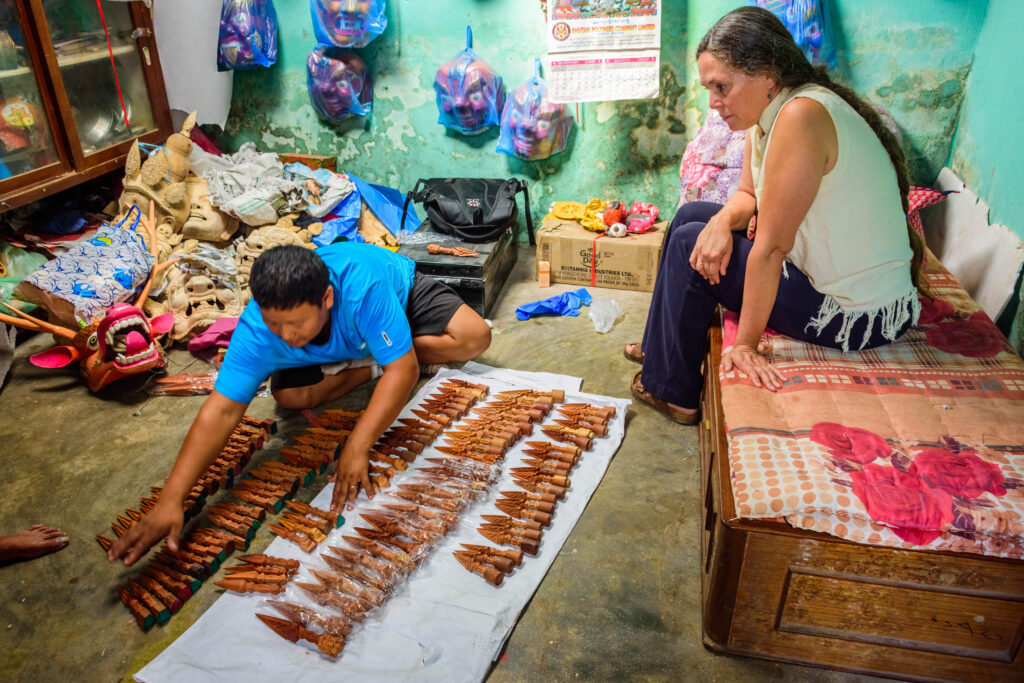
2017 Inspecting phurbas progress
Olivia: And what are the other qualities of the phurba?
Khandro Kunzang: Their ultimate compassion. Right? Ultimately, they’re, they’re symbols of compassion, right? Because it’s, what’s underneath all that anger, what’s really, what’s underneath all of it is really compassion, but [00:55:00] it’s being veiled, right? So it’s a swift method for removing the veils to reveal one’s ultimate compassion, right?
So there’s the, there’s the phurba of bodhicitta. Right, so that you develop the ability that through your great bodhichitta, itself can cut through. This is the ability to use compassion as a way of undercutting. Right? So that’s, that’s kind of the ultimate level, right? And then there’s the material phurba, the actual thing, the ritual dagger that’s used in a ritual way.
That’s sort of the relative truth, um, way of working with a phurba to conduct these rituals, right? So there’s, there’s the material physical going into more and more subtle and more and more um enlightened aspects that are, of course, non material. so you know, a phurba practitioner or Vajrakilaya practitioner has to understand these things.
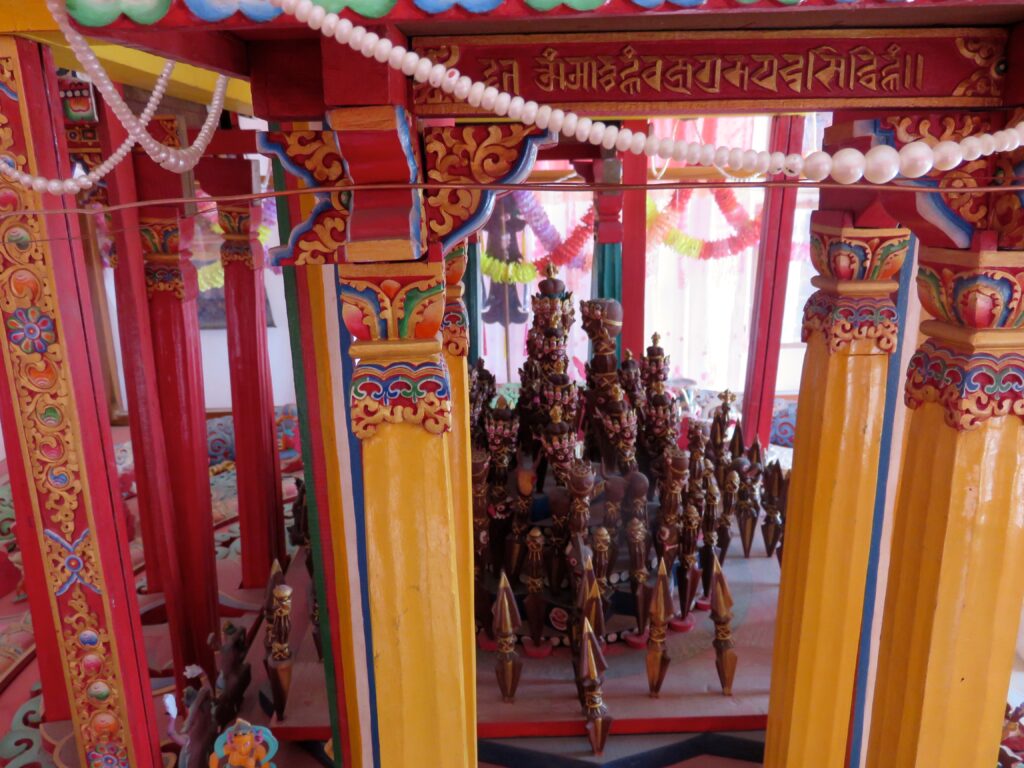
Phurbas inside mandala
[00:56:00] And that’s why it’s really an advanced practice. I mean, I see people really fascinated with Vajrakilaya and they want to get their phurbas and they want to play with their daggers and, and that’s really, you know, it’s not the right idea. You know, it’s, it’s really not. And so you have to have already had some experience of, let’s say, you know, emptiness of self.
To understand the true nature of these wrathful practices and not get caught up in what can seem like kind of occult aspects because it can look like a really occult practice. These rituals, these wrathful rites that we do to, you know, these little effigies we make and put in triangles and, beat them and cut their heads off.
You know, it can look like an exorcism from a shamanic thing, but if you, if you don’t already have these experience of your wisdom awareness as [00:57:00] yourself, as the deity, you’re going to misuse those practices. You’re apt to misuse those or you don’t have the maturity.
And if you do use those practices, this is one of the things Lama Dawa used to say, you know, if you try to do these wrathful practices, because people would want to learn how to do all the wrathful things. And I sometimes get requests from people, you know, will you teach these, you know, – the wrathful rites, you know, and these are people who haven’t done ngondro, they haven’t done the generation of the diety and they just want to do this this magical stuff. And Lama Dawa used to say, if you do that, you don’t have the pride of the deity. You have to have the pride of I’m Vajrakilaya. You have to understand what that means, which is the emptiness of self. Then you try to do this stuff and it’s going to come back on you. You know, that effect will come back on you in a very negative way.
So it’s dangerous. Therefore, they [00:58:00] consider it danger, dangerous if you don’t have, um, the wisdom, awareness, understanding. So that you’re in that meditative state while you’re engaging in these rituals, right? You have to be in this state. Yeah, it takes practice. It takes having done the generation stage retreats sufficiently, you know, and then you can start engaging with these activities.
I would say it’s an advanced practice. But for those who have the prerequisites, for those who are moving on the path, you know, according to the prophecies of Guru Rinpoche, this is going to be the supreme method to undercut this. I heard a story once about, um, during, um, The 90s, you know, when we were sort of at this cold war with Russia, [00:59:00] you know, and it was before the fall of the Russian Empire During the 80s and 90s that Dudjom Rinpoche had certain practitioners, yogis do Vajrakilaya retreat for 10 years, and when they came out of retreat is when the Russian Empire kind of collapsed.
It all, that was like 1989. The Berlin Wall fell. Like, it was interesting. Like, They came out of retreat and then all this kind of stuff happened in the world, you know, and I think, oh, that’s really interesting, you know, which is how these things would work, right? How this wrathful energy would show up was it would just like suck the energy out of some negative manifestation and it would just implode on itself.
Like, that’s really how it works. It’s not that we come in with a bigger bomb and, you know, like, it’s not like this. You know, it just literally sucks the negativity or [01:00:00] undercuts it and it just, whoosh, collapses on itself. So, that’s, that’s how we understand these wrathful practices.
Olivia: And for you with with these building these mandalas, I mean, this is a really monumental time.
I mean, literally monumental, but also just the fact that it’s a long time coming. It’s been, you know, decades in the making. When you’re thinking of just like your path as a teacher and the spaces you hold for retreat, even just what you shared about the Cold War, do you have any aspirations or ideas that come to mind of like ways you might want to hold Vajrakilaya retreats or do things, you know, to continue to support these difficult times?
Khandro Kunzang: Yeah, sure. I’m certainly I can see that going forward how it will show up. I don’t know. I don’t make a plan. I have no plan about it. I just it has to kind of arise right there. There has to be that the interest has to. I have to see that there’s this interest in it. I [01:01:00] probably will start teaching more about Vajrakilaya.
So as we manifest this physical structure It is the opportunity for me to educate people about the importance of it, of the importance of the structure, but also to talk about Vajrakilaya itself, right? So I will be taking more opportunities to start communicating this in a general way.
Like for example, the prophecies that I mentioned, Dudjom Lingpa’s prophecies, Kilaya -, I’m finishing a translation of that and I will be putting that out on Saraswati Buddha Publication site that is all about the prophetic visions of, um, this cycle and why it’s important in the, in the kinds of calamities that Guru Rinpoche.
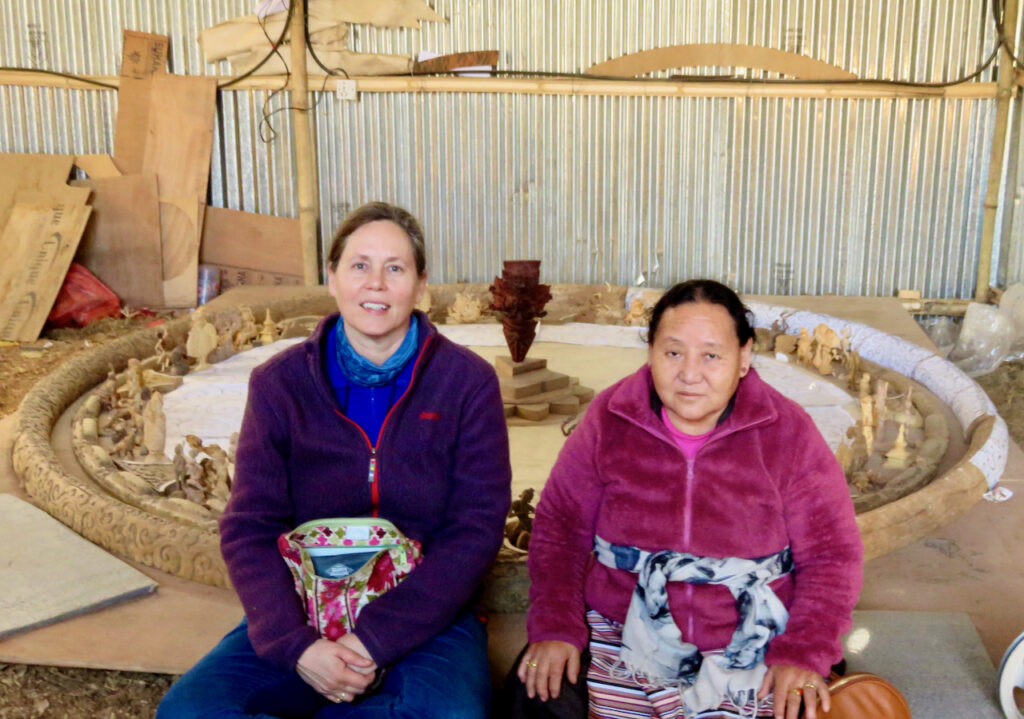
Kunzang & Kalsang Mandala progress
So, so we can see, oh my gosh, you know, we are in this time. Look at how they’re describing the times that we live in to inspire to, to wake up maybe. people’s own, whatever karmic, people have to have the karmic [01:02:00] predisposition for this. Right. And so however that can be woken up and, and certainly I will be doing that.
And, you know, ultimately my, my aspiration is to invite, teach other Lamas to come like Gyepa Rinpoche, these masters to come and to, you know, And then I’m there as a support. I’m more comfortable being the support person, I really
Olivia: am. Why is that, do you think?
Khandro Kunzang: Yeah, it’s just, I, I feel the weight of the responsibility when you, when you are like, a Lama and lineage holding Lama and you’re giving empowerment. It’s a huge responsibility, you know. And so, yeah, I have, I feel very cautious about it because I just see all the problems that can come up with. So, you know, I’m, I’m, I’m sort of tiptoeing my way, letting the, letting the causes, letting to see what shows up.
You know, it’s not something you can, it’s not like a business plan that you, you [01:03:00] know, I’m gonna, I’m gonna do this, and then I’m gonna do this, and this is gonna happen. I, I can’t think that way. My teachers didn’t think that way. That is not the right way. You know, as a teacher, it has to be, there has to be, um, People making these requests of you.
That’s how this tradition works. You, that’s how we have to understand it. We go to the teachers, we make a request, and based on the requests, they manifest. Like all, all of these things, all of the texts, the texts I just mentioned, um, came because a student requested this of Dudjom Lingpa, and so therefore this comes out, right?
And then we all benefit from this. Yeshe Tsogyal requests Guru Rinpoche. To give, um, ideas about the future. And so then he speaks this and she writes it down and hides it as terma. There has to be the request. It can’t be, I’m a teacher with my ambition and I’m going to create my [01:04:00] Dharma center with It can’t be like this.
Has to kind of have this organic growth of the right people coming because of karmic connections, making, and then you seeing the need for this or feeling prompted, okay, it feels like it’s time for this. It has to be like this.
Olivia: Feels very mandala principle oriented.
Khandro Kunzang: Very mandala principle, yes. And if it’s meant to happen, it will happen, right?
So I don’t really, I don’t make a plan about it. If it’s meant to happen, it’ll happen on its own like this. But there has to be the maturity of the students, too. For something like this, I have to see the maturity of the students,
Olivia: you mentioned the story with Guru Rinpoche and the original arising of Vajrakilaya teachings itself in Yanglesho, do you want to share about that story?
Khandro Kunzang: I’ll see if what I can remember about it. Yeah. I mean, he, he was in Yanglesho. Yeah. practicing and there was all kinds of [01:05:00] disruptions. He saw that he needed to have a way to deal with obstacles.
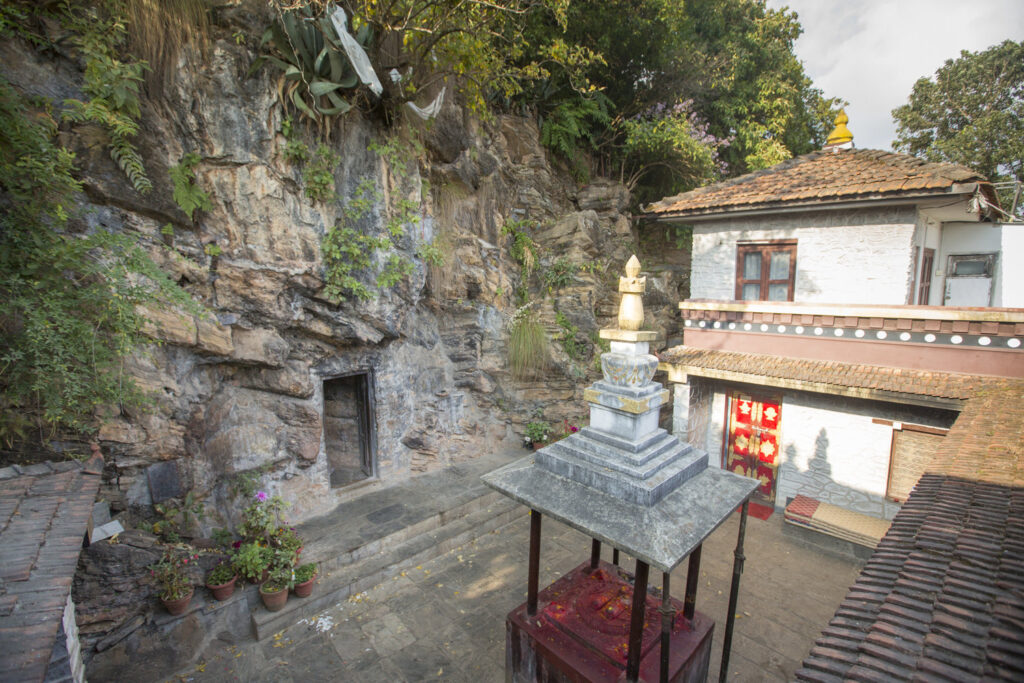
Yanglesho cave via Nekhor.org
So he sent some of his attendants, one of them was a Nepali man, to Bodh Gaya to get this particular cycle, which they receive from a Dakini. You know, so like there’s this kind of mysterious Dakini involved in this story of, of Vajrakilaya that we don’t know a lot about. But anyhow, he received these texts and then he did the Vajrakilaya practice and actualized the Vajrakilaya practice and subjugated many of the The disturbing spirits that were arising in that area.
And so, and then while he was engaged in that practice is when King Trisong Detsen sent an emissary to him to say, please come to Tibet because the King was trying to establish Buddhism as the national religion. And they were having so many [01:06:00] problems. They were trying to build this monastery and the spirits were disturbing.
And of course. that was mostly a Bon shamanic culture. And there was a lot of resistance to bringing this Buddhism. So they, you know, he was advised to invite this, you know, this tantric master Padmasambhava. So well, where was he? Well, he’s in Nepal, you know, in this cave. So he was doing Vajrakilaya practice and actualizing those activities.
as this request came. So yes, it, it sort of like marks the beginning of our, um, story with Guru Rinpoche’s connection with Tibet, right? Those were the interdependent connections that came together for him to go to Tibet and then establish, help to establish the Vajrayana. Buddhism in Tibet. And so the Vajrakilaya played a really important role in that.
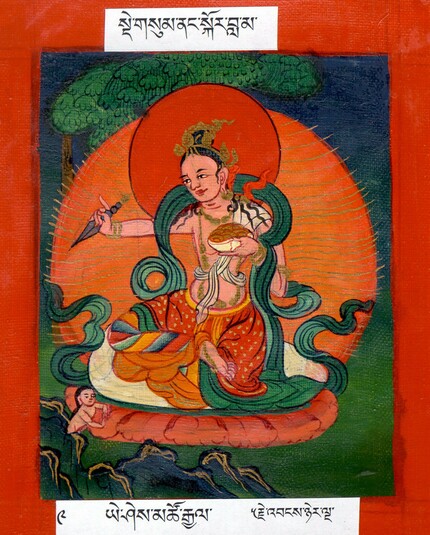
Yeshe Tsogyal, painting from 19th C Tibet from Shechen Archives through Himalayan Art Resources
And then, and then Yeshe Tsogyal, you know, when she had to go, there’s the story of when she [01:07:00] had to go find her consort, right? She had to go find Atsara Sale in, in Nepal, right? Nepal was just this little kingdom in Bhaktapur at that time. And she had to make this arduous trek across the mountains to go find this guy, right?
Of course, there’s no email or phone number or name. He, she just knows, you know, he’s got a red mole on his chest and, you know, some kind of marks and signs on his body like this. And then she shows up at the market, the square where, you know, that’s where you go. When you go to these towns, you go to the market square and then you’re noticed.
And he walks right up to her and says, Hey, you’re looking for me. You know. but he was an indentured servant, he was an Indian, foreigner, in Nepal as a servant, and she had to buy him, you know, from the woman who owned him. And she needed a lot of money to do that, which she didn’t have. She had used up all her gold that she had.
[01:08:00] brought on this journey. And then this opportunity arose where some noble person’s son had suddenly died. And she resurrected him using Vajrakilaya practice. She used the Vajrakilaya practice to sort of resurrect him from the dead. And so that’s what we’re As gratitude, this, the parents of this boy, you know, what do you want?
And she’s like, well, I need this much gold, you know, so that’s how she got the gold to buy at Atsara Sale to bring him back to Tibet was, that was through Vajrakilaya activity practice, right? And then this, as the story goes, um, when Guru Rinpoche is teaching, Yeshe Tsogyal, And she’s specifically requesting Vajrakilaya practice.
Why is she requesting this? Because of all the problems she has as a woman practicing. And she has this long lament of all the difficulties she’s had to [01:09:00] endure being a woman, trying to do this practice, how she’s been maligned, all the gossip that follows her, all the obstacles. So she felt I need to do this.
I need to have a way to remove all these obstacles that I’m encountering trying to practice as a woman. And so for her, she makes this specific request of Guru Rinpoche to teach her Vajrakilaya. He was actually saying, you should do Amitabha practice. That’s the supreme practice. And she’s like, no, no, I need, I have so many obstacles.
I want the Vajrakilaya practice. So that became the, the condition for her to receive this. Practice from him in the first place, which I think is interesting. You know, it’s, it’s, it started with a woman and it became Yeshe Tsogyal’s practice to deal with the obstacles she was having doing practice as a woman.
You know, so it’s kind of a woman’s practice in a way, you know, And so, um, so she then got [01:10:00] accomplishment with Vajrakilaya. Then she needed a consort and brought Atsara Saleh, like this kind of thing. You know, so it became central to her ability to be able to continue on her path with no obstacles. Right.
So as practitioners, we use this Vajrakilaya practice, it supports our practice by removing obstacles that can come our way to doing practice. So, you know, it became central. And of course, Guru Rinpoche taught this to the major disciples, and it’s been hidden as termas, and it’s become very pervasive through the Nyingma school and also in the Sakya school.
You know, so Vajrakilaya is a major yidam, but it, you know, it was Guru Rinpoche’s, receiving this text while he’s in Yanglesho then actualizing the practice to deal with the kinds of, um, obstacles that were arising in that area. Some of them had to do with a king. There was a king in Godavari whose son had been turned into [01:11:00] a frog by the local Nagini and he had to go subjugate that Nagini.
That’s in the, the, in Godavari. There’s a place. that commemorates that, where he subjugated the Nagini and got the prince back out from the Naga realm and, you know, there was all kinds of things he did. So he used Vajrakilaya to deal with these kinds of, um, manifestations of problems that they, saw where spirit related .
And then as, as Guru Rinpoche is going to Tibet, he encounters many, many obstacles of different mountains, spirits, and lake spirits, you know, uses Vajrakilaya to deal with that.
Olivia: Well, is there anything else you want to share about the Vajrakilaya Mandala, Vajrakilaya in general? Like anything that makes the mandala unique in terms of its purpose or just anything else you want to share? You’ve already been quite elaborate. I
Khandro Kunzang: think we’ve, yeah, I think we’ve covered it. I mean, I don’t know of any other three dimensional mandala vajrakilaya [01:12:00] Mandala, other than Bhutan, Bhutan there is one, you know, so it certainly will be the first of its kind in North America and, you know, both in America and Mexico. Um, so that makes it unique. There’s not, there’s a few places that have created smaller three dimensional, um, mandalas, but not, this is large, you know, this is, 13 feet high and like this.
So, um, yeah, that makes it very unique.
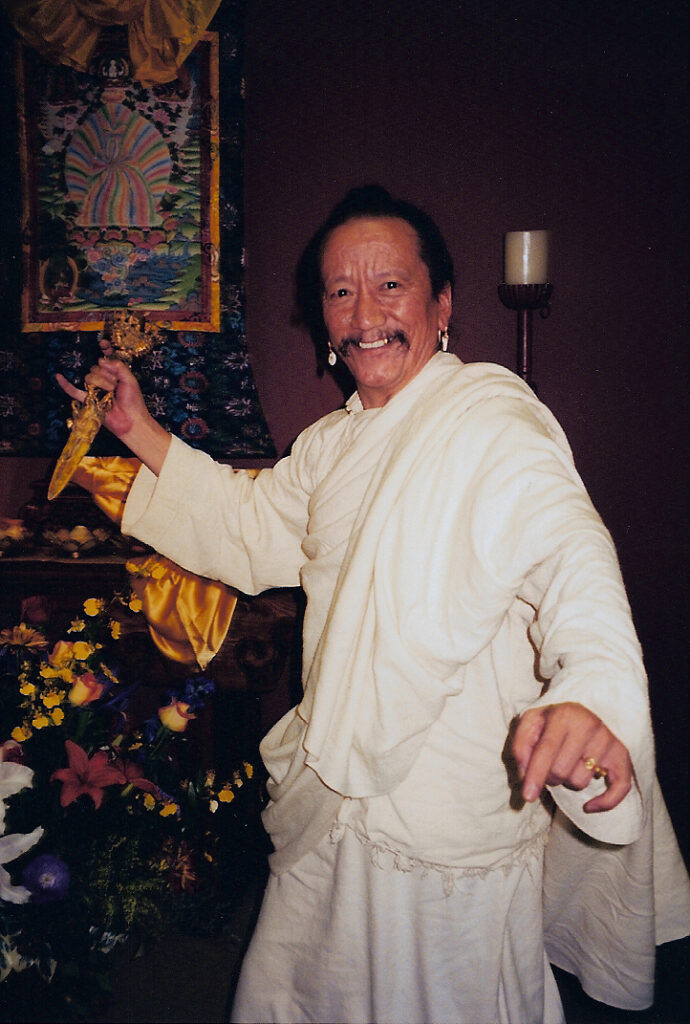
Lama Dawa and a phurba
Olivia: It’s so beautiful. I mean, thank you so much for staying with this vision. it’s definitely important. And I, I hope that it leads to more activities in this way. More wrathfully beneficial activities.
Khandro Kunzang: so do I, I mean, I’m feeling of course, with all the things going on in the world today, the timing of this, it couldn’t be sooner, but it, you know, it’s just, I trust the timing.
I mean, I didn’t know when are we going to do this? Cause it’s really hard to raise money. And then we, you know, this year, this wonderful [01:13:00] sponsor showed up and, um, we had this grant and they’re a hundred percent behind this project, you know, so it’s just, it’s timing. You know, it’s, it’s the ripening of causes and conditions.
And of course our practices that we’re doing to generate, to, to create auspicious circumstances. And I just trust the timing, you know, and then, so our timeline is next year, 2025. The buildings built and then the interior and we’re planning the consecration and that’s when I’ve asked Gyepa Rinpoche to come in 2026.
That’s our timeline. I, you, I feel it’s important to have deadlines because a deadline really, there’s something energetic about a deadline. I found this with when we built the The stupa. I had no idea how to build a stupa. We made a deadline. We said we’re going to consecrate it at this time. And there’s something about that that mobilizes energy when you have this deadline.
So, um, it’s important to make a specific [01:14:00] time. We’re setting things in motion and, um, and then the, the Mexico mandala. I’m very committed to helping them, too. They still have to buy the property. They have to buy land. They have the mandala now. That’s finished. Now they have to buy, you know, buy the property.
Then the Nepal mandala is, It’s, it’s sort of taken care of itself, right? So I’m also committed to seeing these installed and consecrated as quickly as possible. That’s my main focus. I, you know, I’m, I may not be teaching as much next year because I will be very involved in this.
Olivia: Well, thank you so much, Khandro Kunzang. Always a pleasure to be in your presence, and
Khandro Kunzang: thank you very much. And I hope we meet soon.
[01:15:00]
